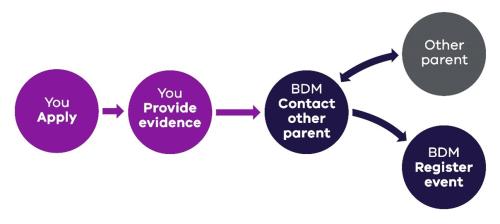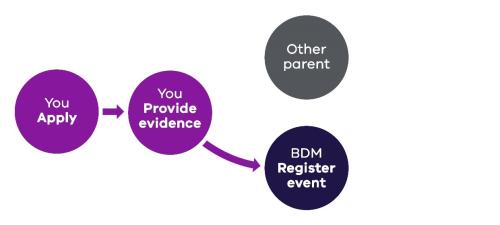
When accessing BDM services, our priority is protecting you and your family’s safety. Our processes take this into account.
We can support you if you have experienced family violence.
If you tell us that you have concerns for your safety, we can protect your information from the other parent.
For example, we don’t have to tell the other parent your address or contact details without your consent.
If you can’t let the other parent know your address due to safety concerns, you can either:
- Option 1: Ask us to contact them on your behalf, or
- Option 2: Tell us that we should not contact the other parent.
We may ask you for documents to support your concerns.
Family violence support services
If someone is in immediate danger, call triple zero (000) and ask for police.
If you or someone you know needs help, there is a wide range of family violence support services(opens in a new window).
Aboriginal services
The Marguk-bulok koolin-ik Team (Aboriginal Outreach) are here for mob. To get in touch please:
Option 1: Ask us to contact the other parent on your behalf

We can contact the other parent on your behalf. For example, we may ask them to:
- Complete your child’s birth registration, or
- Provide evidence needed to complete the application.
We won’t pass on any of your contact details to the other parent.
We only share the child’s name.
To complete this option, provide one of the following:
- A statutory declaration(opens in a new window) explaining your concerns and why the other parent should not have your contact details, or
- Evidence that your safety or wellbeing is at risk.
Examples of evidence that your safety or wellbeing is at risk are a document from:
- A court. For example:
- Current or expired Family Violence Intervention Order
- Victoria Police or another police service. For example:
- Family Violence Safety Notice
- Police statements
- A family violence or other support service. For example:
- Specialist family violence service
- Housing service
- Mental health service
- A health practitioner. This may include:
- A nurse
- Maternal and Child Health nurse
- Midwife
- Medical practitioner
- A hospital
- A lawyer
- A social worker, counsellor, financial counsellor, psychologist
- An Aboriginal Community Controlled Organisation (ACCO), such as:
- Djirra
- Victorian Aboriginal Child and Community Agency (VACCA)
- Victorian Aboriginal Health Service (VAHS)
- Victorian Aboriginal Legal Service (VALS), etc.
The statutory declaration or other documents do not need to include sensitive information about the nature of the family violence.
You must also provide the other parent’s last known contact details. Include their phone number, email, and postal or residential address.
We will then contact the other parent on your behalf.
Option 2: Tell us that we should not contact the other parent

We won’t contact the other parent if it would endanger your safety or wellbeing. This includes the safety or wellbeing of your child or other family members.
Provide a written statement from a person who can confirm your concerns.
Examples of people/services who can provide a statement
- Police officer
- Worker from a family violence or other support service. For example:
- A specialist family violence service
- A housing service
- A mental health service
- Health practitioner. This may include:
- A nurse
- Maternal and Child Health nurse
- Midwife
- Medical practitioner
- Lawyer
- Social worker, counsellor, financial counsellor, psychologist
- Aboriginal Community Controlled Organisation (ACCO), such as:
- Djirra
- Victorian Aboriginal Child Care Agency (VACCA)
- Victorian Aboriginal Health Service (VAHS)
- Victorian Aboriginal Legal Service (VALS), etc.
It must state that if you or the Registry of Births, Deaths and Marriages Victoria (BDM) were to contact the other parent, it would put the safety or wellbeing of you, your child or other family members at risk.
The written statement does not need to include sensitive information about the nature of the family violence.
We may ask for more evidence, depending on the circumstances of your application.
How to state that you have safety concerns
Registering a birth
In the section ‘Parent 2 participation’, you’ll be asked:
‘Do you have any safety concerns from Parent 2 being contacted (such as assault or family violence)?’
Choose ‘Yes’.
We will prompt you to add documents when you click Next. Alternatively, you can use the ‘Add documents’ button at any time.
Adding a parent
In the section ‘Participation of parent to be added to the birth record’ you’ll be asked two questions:
‘Will the other parent be filling in their details on this amendment?’
Choose No
‘Why won’t the other parent be filling in their details?’
Select ‘Other’, then enter ‘family violence’ (or similar) in the text box.
We will prompt you to add documents when you click Next. Alternatively, you can use the ‘Add documents’ button at any time.
Learn more about Adding a parent to a birth certificate.
Removing a parent
In the section ‘Correction’, enter the details of the correction. Please make sure you mention ‘family violence’ (or similar) in the text box.
Use the ‘Add documents’ button at any time to upload your documents.
Learn more about Removing a parent from a birth certificate.
How to provide your documents
You can provide documents online or in hard copy.
Upload documents when applying
While filling in the application, you can use the ‘Add documents’ button. In some cases, we will prompt you to upload documents.
You can provide more documents later by logging in to your account.
Learn more about Uploading hard copy documents online.
Email documents to us
If you don’t upload the documents when applying, we will contact you. We’ll provide the email address where you can send your documents when we contact you.
Post documents to us
You can post documents to our mailing address.
Updated

